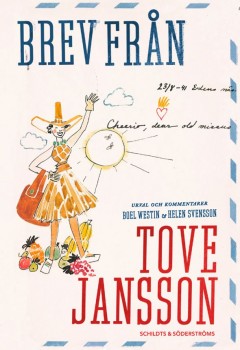The painter who wrote
6 October 2014 | Non-fiction, Reviews
 Brev från Tove Jansson
Brev från Tove Jansson
Urval och kommentarer Boel Westin & Helen Svensson
[Letters from Tove Jansson, selected and commented by Boel Westin & Helen Svensson]
Helsingfors: Schildts & Söderströms, 2014. 491 pp., ill.
ISBN 978-951-52-3408-7
€34.90
In Finnish (translated by Jaana Nikula):
Kirjeitä Tove Janssonilta
ISBN 978-951-52-3409-4
Nothing could be more mistaken than to describe Tove Jansson as ‘Moominmamma’. In her statements she was both cutting and complex – conflict-ridden and full of paradoxes. And she was nobody’s mamma.
Tove Jansson (1914–2001) became world famous (especially ‘big’ in Japan) with her Moomins – the characters of her illustrated books for children (1945–1970) – and her books for adults are a part of her work that is at least as interesting. Her training, ambition and artistic passion were, however, focused on painting.
Anyone who has read Boel Westin’s excellent biography – now available in English, Tove Jansson: Life, Art, Words – ‘knows’ all this, but to experience it through Jansson’s own letters, in an alternating process of reflection and recreation, brings the problems close to the reader in quite a different way: one that is shocking, but also deeply human.
This comprehensive edition of Tove Jansson’s letters to her friends, lovers and relatives is the nicest way I can imagine to celebrate her centenary. Jansson describes her work, her many travels, her loves and her stays on her beloved summer islands Bredskär and Klovharun, on the south coast of Finland. Jansson’s parents were both artists: Viktor Jansson, a sculptor, and Signe Hammarsten (‘Ham’) Jansson, a graphic artist. Her brother Lars (1926–2000) illustrated her Moomin comics for many years, and Per-Olov (born 1920) is a photographer and writer.
Jansson writes early on of her attempts to be free of her ‘terribly misguided consideration for everyone and everything.’ On growing acquainted with her erotic life, infatuation with a succession of self-centred men one realises that in this she was not particularly successful. During his spells of leave in wartime the artist Tapio Tapiovaara wants Tove, but also ‘that husky painted blonde from Roobertinkatu Street’. The left-wing parliamentarian and journalist Atos Wirtanen takes shelter behind a philosophical indifference to ‘conventions’ – such as marriage – which makes him an emotional monster, but a cheerful and good-natured one. He is believed to have been the model for Snufkin of the Moomin world, the vagabond with commitment issues.
Through the dead war years of fear, depression and cold Jansson fights bravely and independently, and conquers the world for herself. After the war she at times feels ‘a strong desire for those dark, dangerous years’ – with the ambivalent attitude to formative experiences, both idyllic and horrific, I imagine to be part of her great artistry.
As a piece of Finnish LGBT history Jansson’s descriptions of the ‘ghost side’ – homosexuality, criminalised in Finland until 1971 –- have a unique value. The forbidden love was also found in artistic circles: dangerous, secret and unspoken, but familiar to many. Sometimes, because of necessity the circles had to be kept relatively small, it bore a hysterical, hothouse-like character in a network where there was ‘mymbling’– the Janssonian word for having sex – in all directions.
When the painter Tuulikki Pietilä (1917–2009) finally makes her entrance it comes to the reader as a great relief – here is a woman who knows what she wants, without devouring her partner. Jansson remains who she is, with her at times difficult family as part of the deal, but the deal works. The two women live together for forty-five years.
The letters to Tove’s (heterosexual) girlfriends Eva Konikoff (who moved to America) and Maya Vanni are marked by soul-searching introspection and brusque humour, as in the case of the inevitable ‘Ham friction’ that occurs when, on a small islet, love for mother must coexist with love for Pietilä.
The editors, Boel Westin and Helen Svensson (Jansson’s former literary editor), deserve credit for an extremely well-produced work. The arrangement of the letters is dynamic, the notes and clarifications exact and illuminating in their dry succinctness.
Throughout the whole book, alongside the passions and disappointments, the bread-and-butter jobs and the material hardship, there is a strong current of grim joy in work.
Tove Jansson writes about travel, painting, love, war, friendship, family, comic strip, theatre, money, and house-building. About her own writing, however, there is very little – as if being an author were as natural as breathing and the beating of one’s heart, nothing worth discussing at all. Could she have regarded it as a compensatory sideline, a substitute for her painting, the great, exalted art that never really came to be? Or was it a refuge, and a deeply private joy?
Translated by David McDuff
Tags: art, autobiography, biography, books for young people, cultural history, writing
1 comment:

26 July 2017 on 1:57 am
Very good website!!!
I hope, the book “Letters from Tove Jansson” will be soon available in English and German!
We hope so, it will be wonderfull!
It’s sad, that this book ist also unavailable in Swedish by Amazon.
We love the biography about Tove from Boel Westin, it’s a great work!